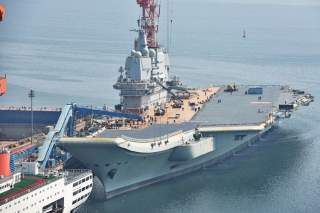This Image Can Only Mean One Thing: China's New Aircraft Carrier Is Almost Ready
Photos that began circulating in mid-April 2019 appear to depict shipyard workers in the port city of Dalian in northern China putting the finishing touches on the Chinese navy's new Type 001A aircraft carrier.
Photos that began circulating in mid-April 2019 appear to depict shipyard workers in the port city of Dalian in northern China putting the finishing touches on the Chinese navy's new Type 001A aircraft carrier.
The photos might confirm what many observers long have suspected. That Beijing wants the new carrier, China's second, to be ready to sail in time for celebrations of the 70th anniversary of the founding of the People's Republic of China, scheduled for October 2019.
The photos of the Type 001A carrier seem to show rapid progress. Scaffolding has disappeared. Workers have applied high-friction deck coating. Four years after work began on the Type 001A and a year after the vessel completed her initial sea trials, the flattop appears nearly to be ready to leave port and potentially commission into service.
Type 001A's commissioning could come just before the October 2019 national celebrations.
Once the new flattop is in service, the People's Liberation Army Navy will operate two carriers, tying it with the U.K. Royal Navy for the status as world's second-largest carrier-operator. The U.S. Navy has 11 large flattops.
The Type 001A is not a sophisticated vessel. It's a slightly-improved copy of the Chinese navy's first carrier, the Type 001 Liaoning.
Liaoning is a Cold War-vintage, ex-Ukrainian vessel that China acquired in the late 1990s ostensibly in order to convert the ship into a floating hotel. After extensive refurbishment, Liaoning in 2012 commissioned into service. Her air wing includes more than a dozen J-15 fighters plus helicopters.
"China’s current aircraft carrier and planned follow-on carriers will extend air-defense umbrellas beyond the range of coastal systems and help enable task group operations in far seas," according to the U.S. Defense Intelligence Agency's January 2019 report on Beijing's military capabilities.
But the first two flattops lack the steam catapults that U.S. carriers use to launch heavy aircraft. Instead, they boost their planes into the air by way of an elevated ramp.
The ramp-launch method reduces the J-15's effectiveness. "The Liaoning’s ski-jump configuration restricts aircraft takeoff weight, limiting maximum ordnance loads and overall combat power," the DIA explained.
Moreover, the J-15 must operate with very little support from other aircraft types. "The ski-jump design also means [Liaoning] cannot operate large, specialized support aircraft, such as an [airborne early warning] aircraft."
To compensate for the lack of a large AEW plane, the Chinese navy acquired Z-18J and Ka-31 helicopters that carry air-surveillance radars. The helicopters "provide the PLAN a serviceable sea-based AEW capability to help fill that critical gap until newer catapult-equipped aircraft carriers capable of operating fixed-wing AEW aircraft enter service," the DIA stated.
The Chinese navy is developing a jet-powered, carrier-capable drone, but this too is incompatible with the Type 001 and Type 001A carriers.
On Jan. 5, 2018, China Central Television aired a video depicting a Tian Ying drone taking off and landing. The broadcast represented the jet-propelled drone's first public appearance.
Global Times described the Tian Ying -- "Sky Hawk" in Chinese -- as a "high-altitude, long-range and high-speed unmanned aerial vehicle capable of conducting reconnaissance and patrol missions in hostile environments."
The Tian Ying's heavy-duty landing gear and twin nose-wheels are typical of aircraft that conduct high-impact landings aboard aircraft carriers.
"The Sky Hawk will also operate on China's future aircraft carriers that will use electromagnetic catapults," Global Times paraphrased an unnamed military expert as saying.
The first catapult-equipped carrier reportedly is under construction, the DIA reported. The new Type 002, China’s third carrier, "will enable additional fighter aircraft, fixed-wing early warning aircraft, and more rapid flight operations."
In the meantime, don't expect any of China's first two flattops to venture too far from home. "The primary purpose of this first domestic aircraft carrier will be to serve a regional defense mission," the DIA claimed. "Beijing probably also will use the carrier to project power throughout the South China Sea and possibly into the Indian Ocean."
David Axe serves as Defense Editor of the National Interest. He is the author of the graphic novels War Fix, War Is Boring and Machete Squad.
Image: Facebook.

